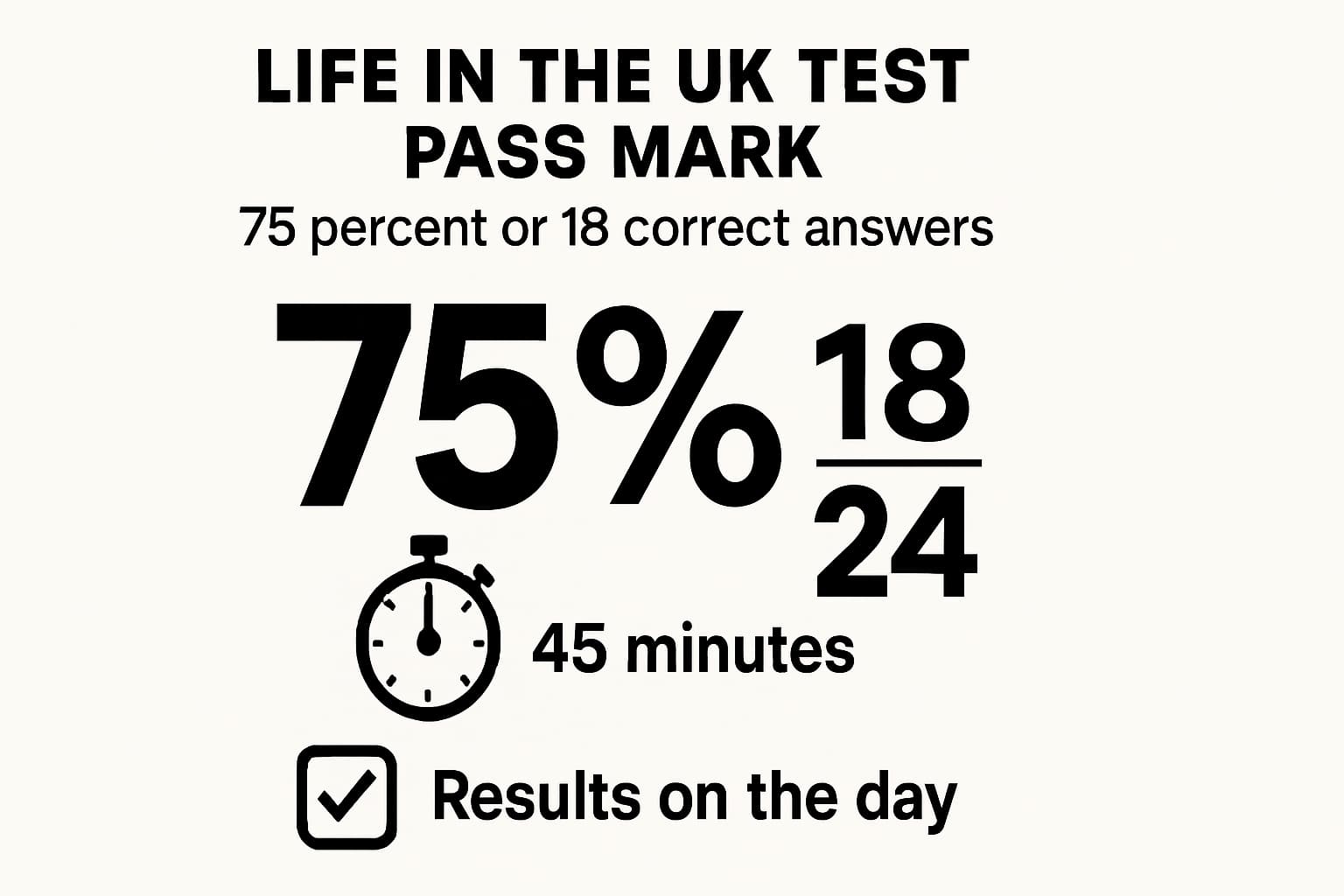Life in the UK Test Pass Mark and Results Explained

Need a clear answer on what score you must get to pass the Life in the UK test and how results work? Here’s the definitive guide: the exact pass mark in 2025, what happens on test day, how you receive your result and URN, retakes, and a smart study plan designed to help you pass first time.
We will break everything down into quick, plain-English sections with official references and practical tips. If you are just starting out, you may also find our primer helpful: What is the Life in the UK Test?
What Is the Life in the UK Test Pass Mark in 2025?
Short answer: The Life in the UK test pass mark is 75%, which equals 18 out of 24 questions correct on the day. This fixed threshold applies in 2025 to both citizenship and settlement (ILR) applications and is confirmed by official guidance (GOV.UK and the Home Office KOLL policy).
For clarity, independent legal resources echo the same requirement of scoring at least 75% to pass (Paragon Law).
Percentage vs. Raw Score: 75% or 18/24
Because the test has 24 multiple-choice questions, 75% translates to 18 correct answers. Anything below 18 correct (e.g., 17/24) is a fail (DavidsonMorris).
Citizenship vs. Settlement: Same Pass Mark
Whether you are applying for British citizenship or Indefinite Leave to Remain (ILR), the pass mark is the same: 75%. Your result supports either type of application (GOV.UK).
No Scaling or Curving
There is no scaling or curving of scores. Questions are randomly generated and you must reach the fixed threshold of 18/24 regardless of perceived difficulty (DavidsonMorris notes variability in question types, including some with multiple correct answers).

How Scoring Works on Test Day
The test is computer-based and administered by PSI across UK test centres (Home Office KOLL policy). You will answer 24 questions in 45 minutes, and all questions carry equal weight.
Question Count, Timing, and Weighting
Here is the core format at a glance:
Element | Details |
|---|---|
Questions | 24 multiple-choice (GOV.UK) |
Time | 45 minutes (GOV.UK) |
Weighting | Equal weighting; no negative marking |
Answer formats | Some questions may require multiple answers; read carefully (DavidsonMorris) |
Submitting Answers and Changing Them
On screen, you will select your answers and can navigate through the questions before finishing. Test centre staff will brief you on the interface. Once you submit your test, your answers are locked and cannot be changed.
Borderline Outcomes: 17/24 vs. 18/24
17/24 is a fail, 18/24 is a pass. Because there is no scaling, you should aim to comfortably exceed the pass line. A good safety target is 20–22 correct, which protects you against tougher question sets and nerves.
Life in the UK Test Results: When and How You Get Them
Results are straightforward: you are told if you passed shortly after you finish, and you receive documentation with a reference number that you will use in your application.
Immediate Feedback at the Test Centre
According to the Home Office, people are told on the day whether they have passed or failed (KOLL policy). Expect to wait briefly after submitting while the system confirms your result.
Your Pass Notification Letter and URN
If you pass, you will receive a pass notification and a unique reference number (URN). Keep this safe; you need it for your ILR or citizenship application (GOV.UK). If you tested on or after 17 December 2019, your reference number also appears in the email sent to you, typically in the format HOM/010114/123456/123456789 (Home Office Guide AN).
Note: If you tested before 17 December 2019, you may have a test reference ID instead of a URN (GOV.UK).
Do You Need to Log In for Results?
There is no separate public “life in uk test result login” portal. You get your result at the centre and your reference details are provided on your pass notification and by email where applicable (GOV.UK; Guide AN). Keep these documents and emails secure.
Using Your Result for ILR or Citizenship
When you apply for ILR or citizenship, you will be asked to provide your Life in the UK test reference. The Home Office uses this to verify your pass (GOV.UK). For full application guidance, see our comprehensive guide: How to Get British Citizenship: The Complete Guide.
Pass Rates: How Hard Is It to Reach 75%?
Many candidates pass first time with focused preparation. While pass rates can vary by test centre and year, the 75% threshold is highly achievable with consistent practice, good English comprehension, and familiarity with the official handbook content.
UK National Average Pass Rates (Overview)
Public reporting indicates that pass rates fluctuate across regions and over time. The takeaway: don’t chase an exact national average—focus on a preparation plan that consistently delivers scores above the pass line on realistic mocks.
Why Pass Rates Vary
Preparation time and method: Candidates who study the official handbook and take many mock tests tend to score higher (KOLL policy confirms the test is based on the official handbook).
Language level: Better English comprehension reduces misreads, especially on multi-select questions.
Test-day nerves and time management: Practising under timed conditions helps you avoid rushed mistakes.
Variability in question sets: Questions are randomly generated and can vary in difficulty (DavidsonMorris).
Setting a Safety Target: Aim for 20–22/24
Because there is no scaling, a practical goal is to average 20–22 correct in your practice. This gives you a buffer against tough questions and test anxiety, increasing the odds of a first-time pass.
Need a step-by-step booking walkthrough? Read: How to book the Life in the UK Test: step-by-step. There are more than 30 test centres across the UK, including in Wales and Scotland (Paragon Law), and you can take it in Welsh or Scottish Gaelic in the respective nations (Home Office KOLL policy).
If You Fail: Retakes, Timing, and Appeals
Failing is not the end. You can rebook and try again. Plan your next attempt smartly to avoid repeated fees and delays.
Waiting Period and Rebooking
If you do not pass, you must wait at least 7 days before booking a new test (DavidsonMorris). You can rebook as many times as you need, but you pay each time (GOV.UK).
Review your weak topics within 48–72 hours.
Drill targeted questions and revisit the handbook sections you missed.
Sit 3–5 timed mocks and track your average.
Rebook only when your mock average is consistently above 85%.
Costs of Retesting
Each attempt requires a new payment, and refunds are not issued for failing (DavidsonMorris). Minimising retakes saves both time and money—preparation that pushes you well above the pass mark is the best strategy.
Appeals: When They’re Possible
You can raise issues if there are identity problems, procedural errors, or technical faults during your test. Speak to staff immediately so it can be recorded. Note that question difficulty is not grounds for appeal. Always bring the exact ID used for booking and consent to a photo, or you may be refused the test with no refund (GOV.UK).
Preparation Strategy: Exceed the Pass Mark
Your goal is to arrive at test day already scoring well above 75% on realistic practice. Here is a structured plan and the tools that make it simple.
Study Plan: From Handbook to Mock Mastery
Use this 2–4 week plan to build knowledge and speed. It is based on the official handbook and exam-style practice:
Week 1: Foundation
Read the official Life in the UK handbook cover to cover. The test is based entirely on this content (KOLL policy).
Start topic quizzes to check comprehension.
Week 2: Practice and Feedback
Do daily mixed practice sets under light time pressure.
Review explanations for every error and note weak topics.
Week 3: Timed Mocks
Attempt 4–6 full timed mocks. Target 85%+ averages.
Introduce harder sets and multi-select questions.
Week 4 (optional): Fine-tune
Focus exclusively on previously missed topics.
Maintain 2–3 mocks with 85–90% scores.
Use the Life in the UK Test App to Stay On Track
The Life in the UK Test App is designed to remove the common blockers that cause retakes:
Complete handbook on mobile: Read anywhere, without carrying a book.
Smart assistant (Brit-Bear): Get targeted explanations and quick refreshers when stuck.
650+ exam-style questions with explanations: Build depth, not just recall.
Hard Mode mocks: Train for tougher question sets so 75% feels comfortable.
Readiness score: See when you are consistently above the pass mark.
Offline access: Keep progressing even without Wi‑Fi.
Try it now and avoid last-minute cramming or costly retests: Download on App Store: iOS download · Get it on Google Play: Android download
Mock-Test Benchmarking: When You’re Ready
Use clear benchmarks so you know when to book or rebook:
Book the test when: You score 85%+ on 5 recent timed mocks and no single topic is below 80%.
Rebook after a fail when: You have three consecutive mocks above 85% and have reviewed every previous error.
Final 48 hours: Two timed mocks per day plus targeted revision of your weakest sections.
For more practice, try our free practice Life in the UK test and avoid the 7 common test mistakes that trip up candidates.
FAQs: Quick Answers About Pass Mark and Results
Is the pass mark always 75%?
Yes. The Life in the UK test pass mark is a fixed 75% (18 out of 24) for both ILR and citizenship. There is no scaling or curving (GOV.UK).
Can I view my result online later?
You are told on the day, and your pass notification includes a unique reference number. Post-2019 tests also show the reference in your results email. There is no separate public results login (Guide AN).
Does a pass expire?
There is no expiry date on a Life in the UK test pass, but keep your unique reference number safe for future applications (DavidsonMorris).
Can I appeal if I think questions were too hard?
Difficulty is not appealable. Only procedural or technical issues may be raised. Speak to test staff immediately to log any problem (GOV.UK).
What ID must I bring to the test centre?
Bring the exact original ID used to book. You must also agree to have your photo taken. If you do not, you will not be allowed to test and you will not get a refund (GOV.UK).
Your Next Steps
Focus on understanding the official handbook, practise until your mock scores sit comfortably above 75%, and arrive at the test centre with the right ID and confidence. When you are ready to prepare efficiently and avoid retakes, use the Life in the UK Test App.